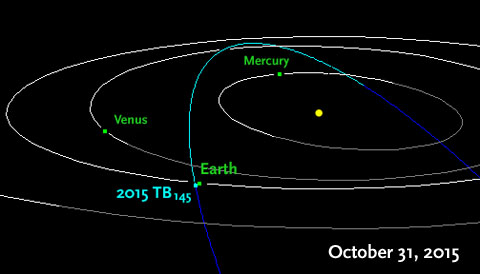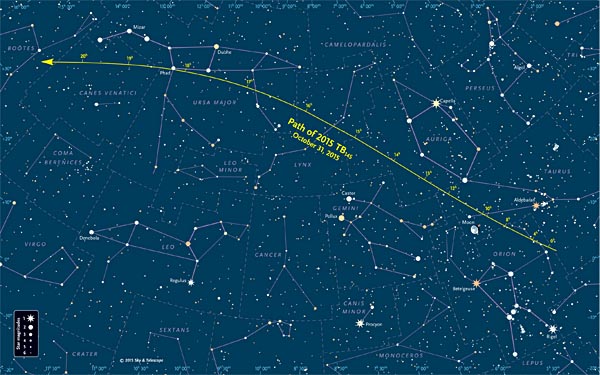The recently discovered asteroid 2015 TB145 won't come especially close to Earth on October 31st, but it's big enough to be seen in medium-size backyard telescopes.
Both professional and amateur astronomers are looking forward to a special treat on Halloween, as a sizable asteroid will hurtle across northern skies. The object, designated 2015 TB145, won't pose any threat whatsoever when it passes by on October 31st — a miss distance of 487,000 km puts it 30% farther away than the Moon's orbit. But its estimated size, roughly 300 to 400 m (¼ mile) across, means that it will briefly brighten to 10th magnitude — well within the capabilities of many backyard telescopes.

Pan-STARRS
Astronomers first spotted this interloper less than two weeks ago, on October 10th, with the Pan-STARRS 1 survey telescope atop Haleakala on the Hawaiian island of Maui. An animation of the four discovery images at right shows the motion of the interloper, then just 20th magnitude, across northernmost Eridanus.
Calculations quickly showed that, assuming a modestly reflective surface, 2015 TB145 must be a relatively large near-Earth asteroid. In fact, the IAU's Minor Planet Center has determined that nothing this large has come this close to Earth since 2004 XP14 in July 2006 — and the next predicted encounter of this size will be 1999 AN10 in August 2027.
So how, despite the constant celestial scrutiny by Pan-STARRS and other survey telescopes, did this one escape detection for so long? The answer comes from its unusual 3.04-year-long path around the Sun.

NASA / JPL / Horizons
First, the orbit's extreme eccentricity, 0.86, means that this body ranges in its heliocentric distance from just inside Mercury's orbit to the outer fringes of the asteroid belt. Usually it's well beyond the orbit of Mars. Second, the orbit's 40° inclination made this asteroid rather difficult to detect, explains Paul Chodas (Jet Propulsion Laboratory), who heads NASA's Near Earth Object Program. "It spends most of its time at large southerly ecliptic latitudes, even as it approaches Earth."
Observers are Getting Ready
In any case, the passage of 2015 TB145 will be a boon for observers in Asia and a relative bust for those in North America and Europe. At first glance (see the chart below), the sky positioning looks excellent: it's closest to Earth while cruising through Ursa Major and passes just ½° from 2nd-magnitude Phad in the Big Dipper's bowl.
But the time of closest approach, at 16:59 Universal Time (according to JPL's Solar System Dynamics website), corresponds to daylight all across North America. So would-be asteroid seekers in those locations must instead look several hours earlier, before dawn on October 31st, when the asteroid will be crossing the northwestern corner of Orion and eastern Taurus. Unfortunately, you'll have to fight the light from a fat gibbous Moon not far away. For those in western Europe, Ursa Major will be above the northern horizon (but not by much, depending on your latitude) as the asteroid is passing through in early evening on the 31st.

S&T: Gregg Dinderman
Important: Sky & Telescope's chart shows the asteroid's geocentric coordinates — its apparent path as seen from Earth's center — and you won't be able to point your telescope based on the track shown above. Moreover, the asteroid's proximity to Earth will create a positional shift in the sky due to parallax of ½° or more. So if you're intent on trying to observe 2015 TB145, you'll need to get celestial coordinates specific to your location. Also, the flyby velocity is an unusually high 35 km per second, meaning the asteroid's position will change by more than a lunar diameter every 3 minutes when closest to Earth.

Brian D. Warner
Meanwhile, professional astronomers are already tracking the asteroid intensively. Observers at the Center for Solar System Studies in California used two nights' tracking to determine that 2015 TB145 rotates every 3.1 hours. That's relatively slow for a near-Earth asteroid. "If the 3-hour rotation period holds up," Benner notes, "we could record nearly two rotations on October 31st."
The relatively slow rotation will be a boon for radar astronomers, who are readying an assault using dishes at NASA's Goldstone facility in the Mojave Desert, the Green Bank Telescope in West Virginia, and Arecibo Observatory in Puerto Rico. These radar probings could resolve details on the asteroid's surface as small as 2 meters. Based its highly eccentric orbit, there's even some suspicion that 2015 TB145 might be cometary in nature.
"The flyby presents a truly outstanding scientific opportunity to study the physical properties of this object," Benner says. "This could be the best radar target we've had since 2005 YU55 about four years ago."
So let's all sit back and enjoy the show. For those of us unable to watch this asteroid glide using our own scopes, Gianluca Masi has marshaled a network of observers to provide real-time views via his Virtual Telescope webcast. It begins at 0:00 UT on October 31st, which is 8:00 p.m. EDT on October 30th.
 0
0